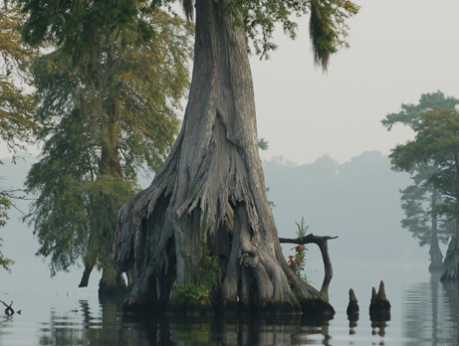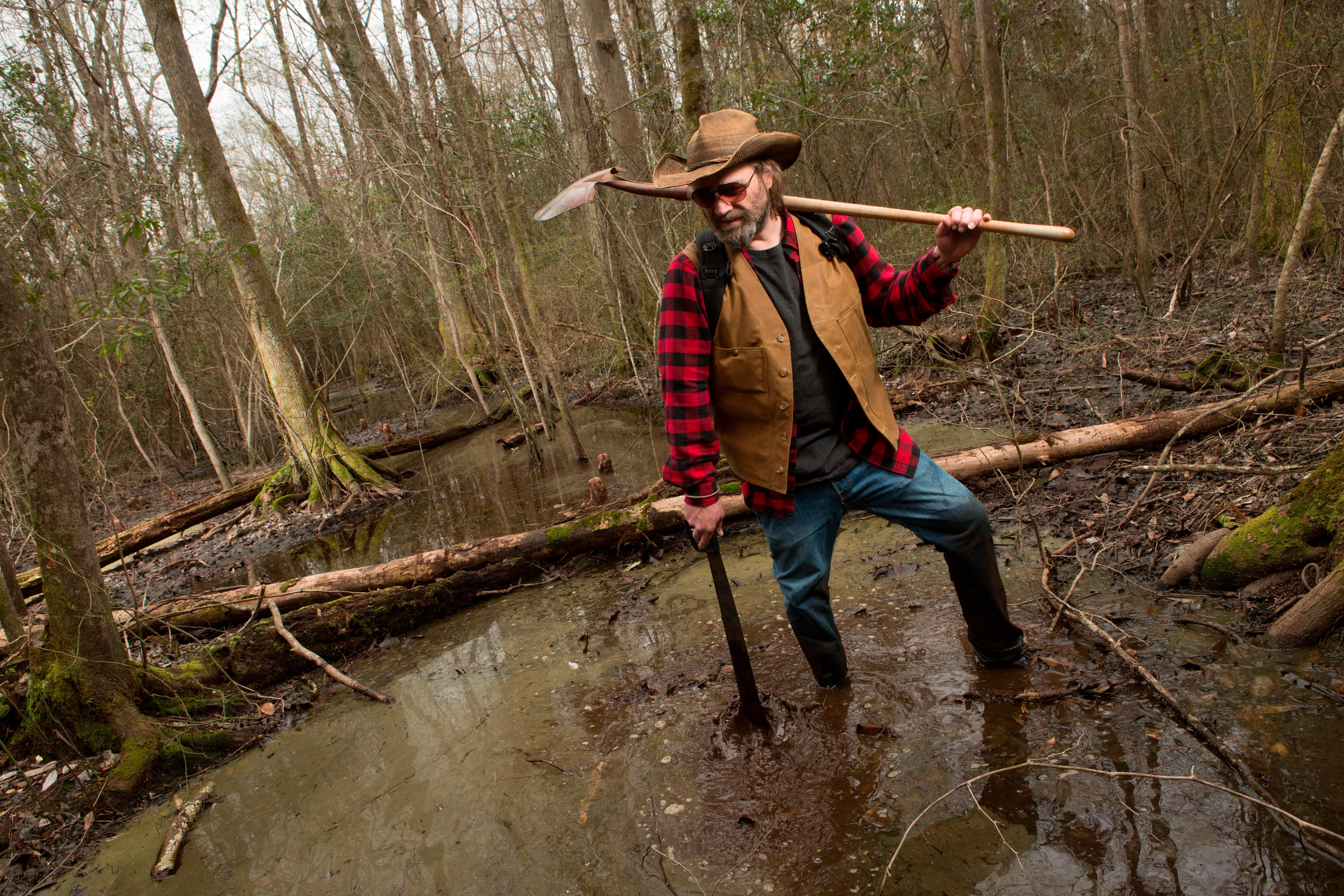The Great Dismal Swamp : A Desolate Place for a Defiant People
The Slave in the Dismal Swamp
In dark fens of the Dismal Swamp
The hunted Negro lay;
He saw the fire of the midnight camp,
And heard at times a horse's tramp
And a bloodhound's distant bay.
Henry Wadsworth Longfellow
"Dar is families growed up in dat dar Dismal Swamp dat never seed a white man, and would be skeered most to def to see one. Some runaways went dere wid dar wives, an' dar childres are raised dar."
"Dar are haps ob folks in dar to work. Most of 'em are fugitives, or else hirin' dar time. There is reefs ob land folks call de high lands. In dem ar canbrakes de ground is kivered wit leaves, kinder makin' a nat'ral bed."
"Dar be whar de wild hogs, cows, wolves and bars be found."
Charlie, runaway slave, 1859
"No one's saying nobody ever ran in there, but there's a difference between a slave running into the Dismal and slaves sustaining communities through generations. If you don't bring in archaeology, all you have is the documents and, if you're lucky, some oral histories. You're talking about a 2,000-square-mile swamp."
"They're not out there writing memos and sending them back to the local courthouse."
"Wait a minute, this is dry ground [2004 exploration]. Suddenly the ground is rising. The trees are 15 feet apart. It feels like a park. You could feel people here, almost."
"Anywhere I put my shovel, I was finding cultural features. [Including the outlines of numerous cabins, where posts had rotted away but left circular stains where once they had been pushed into the ground]."
"There's so much focus on these benevolent, white, bearded guys [19th century Quakers]. Somewhere along the way, this radical black history got co-opted."
"We can talk good words about Quakers and abolitionists. But when they become the only point of conversation, we need to rectify this. The main agents were these maroons who took their lives into their own hands. They said, 'I'm getting the hell out of here'."
Dan Sayers, Chair of anthropology, American University, Washington, D.C.
"There's a lot that's unknowable, but I think we've finally been able to flush out the story. There are less than ten firsthand accounts of what life was like in the swamp, none of them exhaustive. We have to rely on conjecture a lot more."
"It was a peat swamp, which means it's highly acidic. Anything organic would not survive. They recycled these things down to disappearance. You had gun flints used down to the last possible spark."
J.Brent Morris, historian, University of South Carolina Beaufort
 |
| Sayers emerges from the Great Dismal Swamp near one of his research sites. (Allison Shelley) |
A vast tract of marshy, peatland called the Great Dismal Swamp that existed on the border between North Carolina and Virginia was a mysterious place, a place where people hesitated to venture within, yet it captured the imagination. In 1859 reformer James Redpath published a book, Talks with Slaves in the Southern States, focusing on fugitive slaves helping other slaves to escape and find haven in Canada. His book described the swamp area as a "paradise of serpents and poisonous vegetation" but yet a place of haven for runaways.
It is a place with a history of its own, most often described in hushed, fear-laden tones. But the swamp was not entirely unknown to some, as for example as a place where Native Americans were known to hunt since pre-historical times, where marginalized whites and European criminals found refuge from the 1600s forward. Where Africans who were forcibly enslaved joined maroons who had earlier settled deep in the bog unlike other inhabitants who lived and worked around the edges of the swamp.
It was characterized as a "vast body of mire and nastiness" in 1732 by William Byrd II, a planter, frustrated along with other colonials of the time that slaves were hiding themselves within its interior. George Washington was known to have extracted lumber from the swamp around 1760, planning to drain it for farming, without succeeding. In Dred by Harriet Beecher Stowe, a Dismal maroon was the main character. Poets of the day, like Longfellow and Wadsworth immortalized the swamp in dismal verse.
Finally, 1805 saw the Dismal Swamp Canal built, 35-kilometres linked to other waterways and ultimately altering the environment leaving the swamp with 305 of its original 2,000 metres still unapproachably intact, though during the time of the Civil War it was ten times that size. Anthropologist Dan Sayers was certain examining areas of the Swamp would reveal more of its history, as a significant part of the heritage of Black Americans; verifying that many were determined to take the trajectory of their lives into their own hands, escaping slavery.
 |
During more than ten years of field
excavations, archaeologist Dan Sayers has recovered 3,604 artifacts at
an island located deep inside the swamp.
(Allison Shelley)
|
In 2003 he ventured three kilometres into the swamp discovering a part of the refuge's raised islands, particularly a 20-acre elevated area located deep in the swamp interior where he was certain whole communities had once lived. With students from American University his project grew to become the Great Dismal Swamp Landscape Study, between 2010 and 2014, receiving a $200,000 grant from the National Endowment for the Humanities. They ran into black bears and canebrake rattlesnakes and swarms of mosquitoes drove them beyond frustration.
But they discovered the kind of fragments they were in search of; tobacco pipe pieces, fire pits, stone tools, and bits of ceramic. The sand on which cabins were sited was gauged and dated between the 1600s and 1700s. And while Dr. Sayers and his students worked on location, Dr. Morris of the University of South Carolina undertook the documentation aspect of the project. Out of their work came an exhibit on the Great Dismal Swamp installed at the new Smithsonian National Museum of African American History and Culture, in the Slavery and Freedom gallery.
And Dr. Sayers produced a publication detailing the history of the place and his findings which he titled A Desolate Place for a Defiant People: The Archeology of Maroons, Indigenous Americans, and Enslaved Laborers in the Great Dismal Swamp.
:focal(2763x2302:2764x2303)/https://public-media.smithsonianmag.com/filer/51/ee/51ee3608-6f5a-41a9-93d5-3b7d126f6bc2/sep2016_b04_greatdismalswamp.jpg) |
Once 2,000 square miles in Virginia and North Carolina, the swamp today is perhaps one-tenth that size.
(Allison Shelley)
|
Labels: Archaeology, Great Dismal Swamp, History, Slavery, United States

0 Comments:
Post a Comment
<< Home